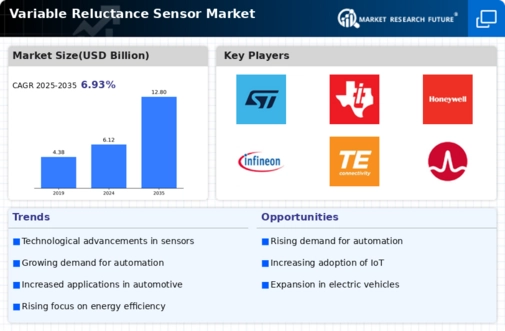Growing Demand in Automotive Sector
The automotive sector is a significant driver for the Variable Reluctance Sensor Market, as the demand for advanced sensing solutions continues to rise. With the increasing focus on vehicle safety and efficiency, manufacturers are integrating variable reluctance sensors into various systems, including anti-lock braking systems (ABS) and electronic stability control (ESC). The market for automotive sensors is anticipated to reach USD 30 billion by 2026, with variable reluctance sensors playing a crucial role in this growth. This trend is fueled by the need for precise measurements and real-time data, which are essential for enhancing vehicle performance and safety. As electric and hybrid vehicles gain traction, the demand for reliable sensing technologies is likely to increase, further propelling the market.
Expansion in Industrial Applications
The Variable Reluctance Sensor Market is witnessing an expansion in industrial applications, particularly in automation and robotics. Industries are increasingly adopting variable reluctance sensors for position and speed sensing in various machinery and equipment. This shift is driven by the need for enhanced operational efficiency and reduced downtime. The industrial automation market is projected to grow significantly, with a focus on integrating advanced sensing technologies. Variable reluctance sensors are favored for their robustness and reliability in harsh environments, making them suitable for manufacturing processes. As industries continue to embrace automation, the demand for these sensors is expected to rise, contributing to the overall growth of the market.
Increasing Focus on Energy Efficiency
The Variable Reluctance Sensor Market is also driven by an increasing focus on energy efficiency across various sectors. As organizations strive to reduce energy consumption and minimize environmental impact, the demand for precise sensing solutions is growing. Variable reluctance sensors are integral to energy management systems, providing accurate data for monitoring and controlling energy usage. The energy management market is expected to reach USD 20 billion by 2027, with a significant portion attributed to advanced sensing technologies. This emphasis on energy efficiency not only supports sustainability goals but also enhances operational performance, thereby driving the adoption of variable reluctance sensors in diverse applications.
Rising Adoption of Smart Technologies
The Variable Reluctance Sensor Market is benefiting from the rising adoption of smart technologies across various sectors. The integration of sensors into smart devices and systems is becoming increasingly prevalent, as industries seek to leverage data for improved decision-making. Variable reluctance sensors are being utilized in smart grids, smart homes, and industrial IoT applications, where accurate sensing is critical. The market for smart technologies is projected to grow at a CAGR of 15% over the next few years, indicating a robust demand for advanced sensing solutions. This trend suggests that variable reluctance sensors will play a pivotal role in the development of smart systems, enhancing their functionality and efficiency.
Technological Advancements in Sensing Technology
The Variable Reluctance Sensor Market is experiencing a surge in technological advancements that enhance sensor performance and reliability. Innovations in materials and design are leading to sensors that offer improved sensitivity and accuracy. For instance, the integration of microelectromechanical systems (MEMS) technology is enabling the development of smaller, more efficient sensors. This trend is particularly relevant as industries seek to optimize their operations and reduce costs. The market is projected to grow at a compound annual growth rate (CAGR) of approximately 6% over the next five years, driven by these advancements. As manufacturers continue to invest in research and development, the capabilities of variable reluctance sensors are expected to expand, further solidifying their role in various applications.
















Leave a Comment